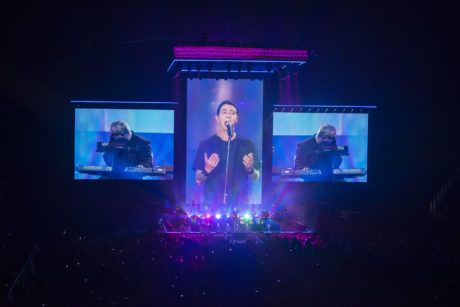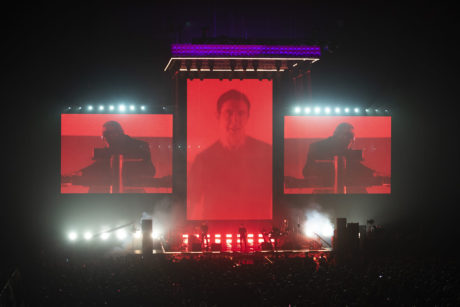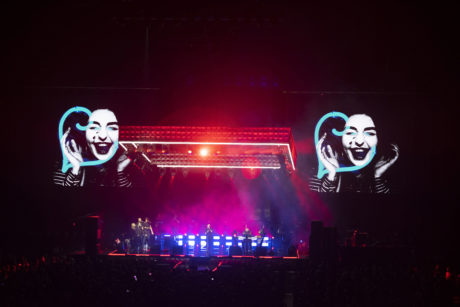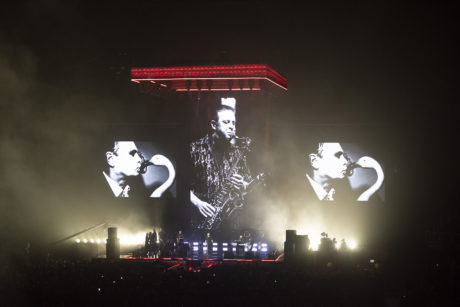
UK – Colour Sound Experiment supplied lighting and LED screens for a massive ‘Wave Goodbye’ gig by UK synthpop duo Soft Cell, who reunited after 17 years to play one final show-stopping performance … at London’s O2 Arena.
More details from Color Sound (www.coloursound.com):
Award-winning lighting designer Rob Sinclair – known for his creative finesse – helped build the ambience and vibes for this historic sold-out pop music moment for the band who’ve occupied some hypnotically catchy and viscerally emotional space in the slightly darker echelons of 1980’s punky synthpop.
Once he was confirmed on the creative team along with set designer Ric Lipson from Stufish, Rob started imagining the lighting, and while hitting the right aesthetic spot was essential for this unique performance, practicalities came in, as this incredibly high profile one off had to get in and out in a day!

It was also being streamed live to cinemas around the UK and Ireland and recorded for a live CD and DVD/Blu-ray release in 2019 – just to add to the pressure!
It was a fine balance, explained Rob, who loves artistic challenges. “You have to be bold in these scenarios and have ambitions – as with any design! If we were constantly sensible and only put in what was guaranteed to be rigged and up easily in time for the show … the results would be safer … but a whole lot blander!”
So, with insipid not in his vocabulary or mindset … Rob didn’t take this route!
Both Rob and production manager Kamal Ackerie agreed early on that they wanted Colour Sound to be involved in the event, “We needed a London company that could supply both lighting and the main video elements … and that had a good sense of humour” he explained.

He’s also worked with H (Hadyn Cruickshank) and the team on previous tours and shows, so knew they would deliver
Architecturally, they wanted a high and narrow stage with clean lines, a modern look that also lent itself to the large displaying of some 1980s vintage Soft Cell artwork. They also wanted the side IMAG screens – that would carry the live camera mix cut by Phil Jennings – to be close to the performance space so it looked like they were involved … rather than an add-on!
Once the stage set and screen layout was evolved, the lighting positions became obvious.
A 9 x 9 metre box truss – clad in a pink metallic-finished fabric surround to emulate the ‘soft cell’ – was installed above the stage on 6 x Kinesys Elevation 1+ motors.
Rob wanted to have lots of fixtures on the rig and the choice of specifics was based around what Colour Sound had in stock, with Robe BMFLs being the main profile. Thirty-six of these, nine a side, were hung around the box truss.

Martin Sceptrons – there were 174 in total on the gig – were used to line the bottom chords of the box truss and of two upstage ‘wing’ trusses, flown stage left and right parallel with the back of the box truss.
More Sceptrons at floor level lined the forestage stage and the small thrust, both built by Brilliant, used in addition to the O2’s house stage.
A 9-metre-wide front truss was loaded with another 10 x BMFL Spots for keys and specials, together with two Claypaky Scenius Unico’s … specifically chosen for the shuttering and focusing needed for illuminating the pink fabric set piece around the box truss.
The two wing trusses were each rigged with 12 x Robe MMX Spots and a Scenius Unico at the offstage ends for picking up the side returns of the pink box truss cladding.
The front and wing trusses were made up from Litec pre-rigged truss which was extremely quick to assemble and rig on the day commented Colour Sound lighting crew chief James Hind, “it literally flew in and up!”
On the floor, 56 x Robe Spiider LED wash beams were deployed … along the upstage set sections – which echoed the pink ‘soft cell’ truss surround vibe right underneath the side video screens, and along the stage left and right edges of the forestage.
Nine GLP JDC1 LED strobes were positioned along the upstage center line on the deck, alternating with Spiiders … for plenty of upstage retina-burn!
Also, for aerial effects, but totally different, were six Novalight Super Novas – a large flower-style effect with a potent 2K lightsource – stationed at the back, two below the offstage edges of the wing trusses and the other two either side towards the back of the forestage. These kicked in for some WOW factor moments, of which there were several throughout the two-and-a-half-hour show.
Mid-stage, two stage lifts – for Marc Armond and David Ball to make entrances and exits – were each lit from below with six Robe LEDWash 600s.
Lighting control was a grandMA2, and video – via a Catalyst media server – was also run through a sperate grandMA2 console.
Rob worked alongside his lighting programmer and director Liam Griffiths as well as closely with video content creators Jack James and Nick Drew at Reality Creative Media (RCM), video operator Luke Whittington and Phil on the live camera mix.
Lighting was programmed to work harmoniously with the playback video content, so there were lots of pinks, blues and purple neon-esque looks and scenes, which contrasted with harsher, starker whites.
For all the foot-tapping popiness there was that meandering sinister undercurrent of Soft Cell edginess and discomfort.
James Hind was joined on lighting by a very strong crew of Sam Kenyon, Jon Rickets, Sam Akinwale, Alex Bratza and Adam LaFemina.
Rob – who admits to occasionally catching himself spontaneously singing along on comms during the show – concluded, “Time was exceptionally tight on the day and we all had a lot to do. Luckily, we had a fantastic team, and everyone worked hard together to ensure it happened”.
Colour Sound’s video crew was chiefed by Fergus Noble who worked alongside Ed Blackwell and Gareth Manicom.
They installed the three LED screens which were all made up from Colour Sound’s new Roe CB5 5 mm screen from the Carbon series, part of a £1 million LED screen investment by the west London based company this year.
The center screen measured 11 meters high by 6.5 wide and this was flanked by two 6-meter-high by 8.4-meter-wide side screens, which all looked very impressive.
H comments, “As always it was excellent working with Rob and we were all very proud to be part of such a landmark show and do our bit to make it memorable for the many Soft Cell fans everywhere”.
Photos : Stufish


